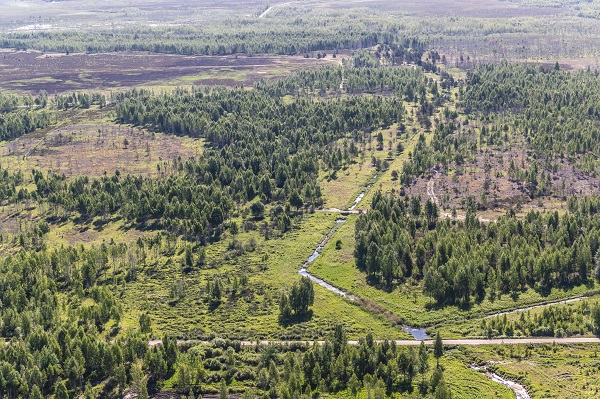Life+ Project Birds in Ādaži has Come to an End
The ambitious European Union LIFE+ programme "Birds in Ādaži" (Putni Ādažos) commenced four years ago was completed at the end of August. In the course of the project co-financed by the European Commission, 1620 hectares of heaths, boreal forests and bogs have been restored in the protected landscape area "Ādaži", which is included in the Natura 2000 European network of natural areas. The project also focused on the promotion of cooperation between the managers of NATURA 2000 military sites and on educating users and visitors of these areas in matters related to natural values. (Photo: Ādaži Military Training Facility/Protected Landscape Area "Ādaži" from the bird's eye view. (c) Sergeant Major Gatis Indrēvics, Battle Audiovisual Group)
The project was implemented by the State Centre for Defence Military Objects and Procurement in co-operation with the National Armed Forces, the Latvian Ornithological Society, JSC "Latvia's State Forests" (LVM) and Sēja Municipality Council.
Environmental experts of JSC "Latvia's State Forests" carried out mapping of natural values within the framework of the development of the nature conservation plan of the territory, while forestry specialists of Rietumvidzeme Regional Forestry implemented part of the measures for restoration of habitats of the bog. "It was a wonderful experience for the company to participate in the European Union LIFE+ project and implement practical measures for the restoration of habitats," said Laila Šica, Head of Environmental Planning.
Ādaži Protected Landscape Area also includes Ādaži Military Training Facility which is not only a training site for the National Armed Forces, but also a territory holding natural values of European significance. In the central part of the military training facility there is the largest heath complex in the Baltic States, where many rare and specially protected birds are to be found.
"Already since 2006, we have been taking nature conservation measures in the military training facility, which in the long run not only provide favourable conditions for rare, protected species and habitats, but also improve and expand the training sites of the National Armed Forces. Heaths just like meadows are disturbance-dependent habitats. Undeveloped heath is overgrown by shrubs and trees, therefore it can last for a long time only when it is regularly managed by grazing, mowing or controlled burning," says Daina Galaktionova, Head of the Environment Protection Division of the State Centre for Defence Military Objects and Procurement.
Gunta Gabrāne, Deputy Director General of the Nature Protection Board in charge of nature conservation issues, points out that the project "Birds in Ādaži" is an excellent example for how different industries can jointly make a significant contribution to the preservation of natural values. "The practical measures of biotope restoration, which are vital for preservation of this fragile ecosystem, are of special importance to the Nature Protection Board," says Gabrāne.
Also elsewhere in Europe, military training facilities are included in the NATURA 2000 network of specially protected nature areas. Intensive military areas make extensive, disturbance-dependent habitats that are rarely to be found elsewhere. Special attention is also paid to the areas between infrastructure objects - natural environment islands, which serve as ecological pockets for animals and plants.
After the completion of the project "Birds in Ādaži", everyone interested in the natural values to be found in Ādaži Military Training Facility are welcome to visit the project website www.putniadazos.lv
Since its foundation in 1999, LVM by implementing sustainable forest management has paid one billion euros to state and local government budgets. LVM's economic activities are carried out by maintaining and recovering forests, taking care of nature conservation, recreation opportunities and increasing timber volumes, as well as investing in expanding the forest land and developing forest infrastructure - renovation of drainage systems and forest road construction. The volume of timber in the forests managed by LVM increases by 12 million cubic metres annually.



